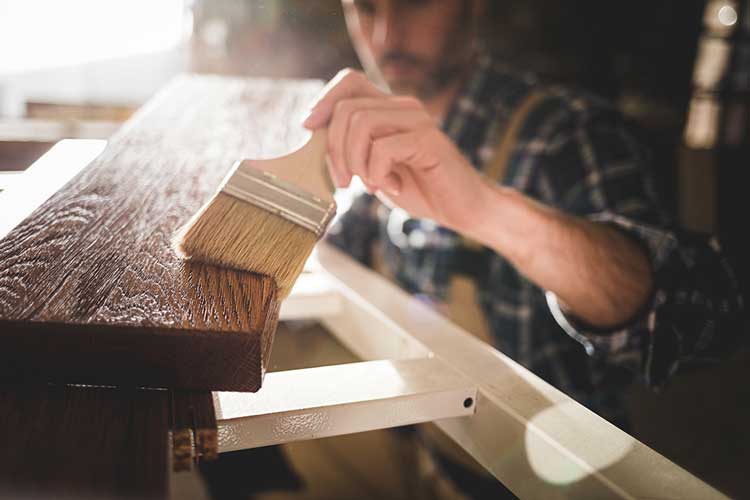Last updated June 5, 2025

On YouTube and TikTok, it can seem as if every third video stars some DIY diva refinishing or upcycling a vintage chest of drawers, often slapping on a coat of near-ubiquitous dark gray paint.
Sharpening your furniture spiff-up skills can be an enjoyable (and money-saving) hobby for some. But for most people, a broken chair leg or a scratched-up dining table means you’ll need to call in a furniture repair pro—or drag your old furniture to the curb. If you invest in a fix, it’ll probably have a higher price tag than you expect.
“Think about the quality of your furniture before deciding if it’s worth repairing,” said Warren Shoulberg, a veteran home furnishings journalist who writes for the industry bible, Business of Home. “Many pieces made in the last 20 years are either throwaway quality or very expensive. You need to decide whether the cost of repairs matches the actual or sentimental value of your sofa or chest of drawers.”
Here are our tips on what furniture repair people can and can’t do, plus how to figure out whether you should repair or replace your beloved dining table/inherited Eames chair or whatever. To find furniture fixing pros, see Consumers’ Checkbook’s ratings of furniture repair shops and upholsterers.
Related: Why Is Furniture Quality So Bad Now?
What Furniture Is Worth Repairing?
In general, any well-crafted, solid wood or welded metal furniture meant to last for years is worth repairing. “A table or buffet that was handed down to you, or an antique or vintage piece you bought, will tend to be better made and more worth refinishing,” said Jerry Warden, owner of Jerry’s Caning in Woodbridge, Va.
Newer furnishings in solid walnut or mahogany, which tend to be more expensive than anything at IKEA or Wayfair, also have finishes that can be redone, dovetail drawers that can be reglued, or a frame that’s worth shoring up and reupholstering.
“I think there’s less repairing and refinishing than there was in past decades,” said Dan Kahoe, a furniture expert and buyer for Washington, D.C. antique store GoodWood. “Nobody is repairing a West Elm chair; they’re buying another West Elm chair.”
Some homeowners want to rehab furniture with sentimental value, whether that’s the Victorian brass bed you inherited from a great aunt or your parents’ groovy mid-century dining console. “If it’s something that’s important to you, that has meaning beyond just being a thing, it might be worth the trouble,” Kahoe said. “But most of the time, you can find the same item again in better shape if you just shop around at auctions or on Facebook Marketplace.”
What’s Not Worth Pro Repairs
Furniture that requires an Allen wrench and a puzzling diagram to assemble (hey, IKEA Billy bookcases!) is designed to be inexpensive and, frankly, disposable. Known as flat pack or ready-to-assemble (RTA), most of it is made of particle board, plastic, or cheap, soft woods (mango, rubber trees). You’ll often put it together with metal brads, plastic shelf supports, and other un-sturdy notions.
Such “fast furniture” might be “easy” to assemble, but it’s not simple to repair. “Anything made out of particle board, if you try to strip it, the board expands,” Warden said. “Plus, if you’re putting something together with a screw or a dowel, it’s hard to repair holes or tighten up a chair.”
What Repair People Can Do
Furniture repair people can strip and re-stain wood and metal furniture, or even give it a slick coat of bright paint. They can replace woven seats on chairs, buff out scratches on damaged wooden pieces, and even carve a new leg for a hobbled end table. Older or damaged metal pieces (brass beds, tables) can be polished, welded, or bent back into shape.
How to Find a Good Furniture Repair Shop
Consumers’ Checkbook’s ratings of furniture repair businesses list a range of fix-up professionals. Besides going through our ratings, you’ll want to:
- Ask to see prior examples of the repair person’s work, preferably in person. Look for flawless wood surfaces, chairs that don’t squeak or wobble when you sit in them, and pieces that appear renewed or nearly new even if they’re decades or centuries old.
- Though many furniture repair people are generalists, others are specialists who only work on—or at least focus on—one type of repair (chair seat reweaving, decorative painting, metal work). For pros you are considering, ask about their strength. Since these are generally experienced craftspeople who take pride in their work, if a repair person can’t do a job, they’ll refer you on to say, a Chinese antique geek or an expert in Chippendale chests.
- Ask for references from prior customers, then call or email them. You can also search for any complaints the shop or individual has received from the Better Business Bureau.
- Once you’ve turned up a few shops that do the sort of repairs you seek, try to get at least three bids. Though Checkbook hasn’t collected prices for furniture repair, in general, we find vast differences in pricing from business to business. It always pays to shop around.
- Ask each repair person you’re considering to put in writing what they suggest your piece needs (regluing frames, stripping, refinishing), how much it will cost, and how long the work will take.

How to Get a Good Repair Job
Don’t expect a bargain: Know that a good repair job might cost as much as or more than buying a similar item to replace your mid-century armchair/Victorian end table/1980s coat rack. “There can be sticker shock,” Shoulberg said. “My wife and I are considering repairing and reupholstering our favorite ottoman, and I expect it to cost twice what it did to buy the thing.”
Try to Avoid a Big Deposit: Most repair shops require a 20 to 50 percent deposit, which protects them if a customer abandons a piece. But the smaller the deposit, the more likely you’ll get quick service along with leverage for demanding corrections if the work is unacceptable.
Square Up Pick Up and Delivery: Most repair shops are just that—a brick-and-mortar workshop. They’ll come to pick up your furniture and then return it after a glow-up. Some businesses charge extra for this service; others factor it into their fees. Some repair people do on-site repairs (righting a broken armoire lock, repairing a broken drawer).
Set a Deadline
Workmanship is your main concern, but promptness is also important—you’ll get some assurance that the shop will do the job in a timely fashion if there is an estimated completion date on the work order.
Pay by Credit Card
The federal Fair Credit Billing Act and the policies of the credit card issuers allow you to contest charges for work you deem unsatisfactory.


